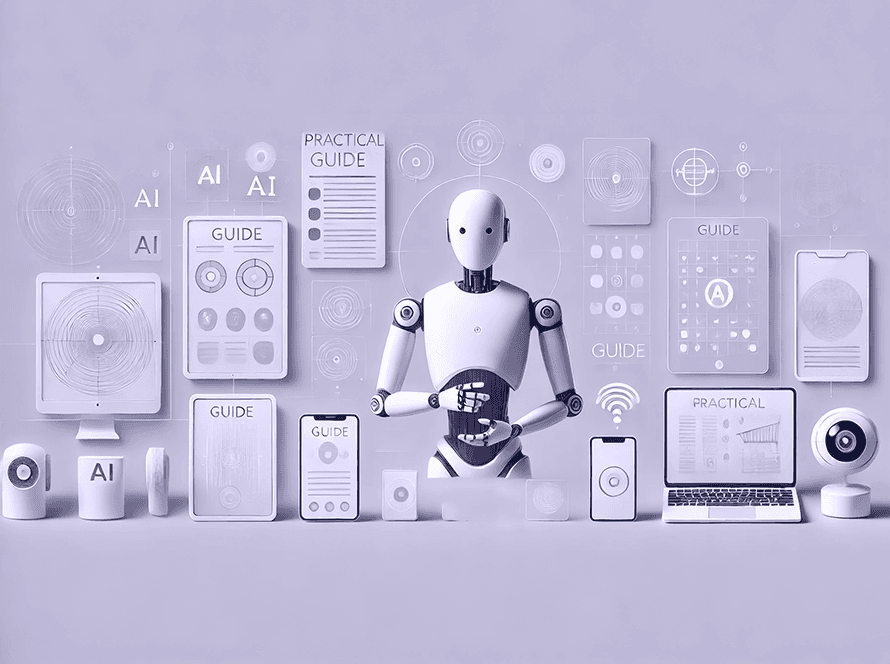“Unlock massive scalability, achieve sub-minute speed-to-lead, and automate your entire top-of-funnel by investing in the right Voice AI Sales Agent Software with a full suite of conversational and analytical tools.”
The relentless hum of the sales floor is a familiar sound. It’s the sound of dialing, pitching, following up, and, all too often, hitting a voicemail. For decades, the core sales process has been a numbers game powered by human effort. More calls meant more conversations, which hopefully meant more deals. But this model has a ceiling. Your team can only make a certain number of calls. They get tired, their pitches can vary in quality, and the administrative burden of logging every interaction is a notorious time-sink.
What if you could break through that ceiling? Imagine a world where every single lead is contacted within minutes of showing interest, where thousands of prospecting calls happen simultaneously, and where your human sales reps are freed from the grind of top-of-funnel qualification to focus exclusively on what they do best: closing deals.
This isn’t a scene from a sci-fi movie. It’s the reality made possible by voice AI sales agent software. These sophisticated platforms are revolutionizing sales by deploying autonomous, conversational AI agents that can handle phone and video calls with astonishingly human-like capabilities. They aren’t just robocallers; they are intelligent systems that understand context, handle objections, and drive the sales process forward.
But with this powerful new technology comes a new set of challenges. The market is suddenly crowded with options, each claiming to be the best. How do you cut through the noise? How do you know which platform has the features you actually need? This guide is your answer. We’ll guide you through everything you need to know to select the right solution for your business, from understanding the core technology to evaluating vendors and making an informed decision.
What Exactly is a Voice AI Sales Agent? (And Why Should You Care?)
Let’s begin by dispelling a common misconception. A voice AI sales agent is not the same as the clunky, pre-recorded IVR system that tells you to “press one for sales.” It’s also far more advanced than a simple auto-dialer that just connects your reps to a live person.
An authentic voice AI sales agent is a software-based entity that uses artificial intelligence to conduct natural, two-way conversations with prospects over the phone or on video calls. It’s designed to perform specific sales tasks autonomously, just like a human agent would.
Think of it as the world’s most dedicated, consistent, and scalable sales development representative (SDR). It never has a bad day, it never gets discouraged by rejection, and it can work 24/7 without a coffee break.
How Does the Technology Work?
The magic behind these agents lies in a stack of interconnected technologies working in perfect harmony:
- Speech-to-Text (STT): At the most basic level, the AI needs to understand what the human on the other end is saying. STT engines instantly transcribe spoken words into digital text, which the AI can then process and analyze. The accuracy of this component is critical; mishearing a single word can change the entire meaning of a sentence.
- Natural Language Processing (NLP) & Natural Language Understanding (NLU): This is the “brain” of the operation. Once the words are transcribed, NLP and NLU algorithms analyze the text to determine the intent, sentiment, and key entities (such as names, dates, or company information). It’s the difference between simply hearing “I’m not interested right now” and understanding it as an objection that requires a specific, empathetic response. This is the core of a natural language sales agent.
- Conversational AI Core (The “Dialogue Manager”): This component decides what to say next. It accesses a dynamic script, a knowledge base, and a set of pre-programmed responses to objections and questions. Based on the NLU’s interpretation of the prospect’s words, the dialogue manager selects the most appropriate response to keep the conversation flowing and guide it toward the desired outcome, like booking a meeting.
- Text-to-Speech (TTS): After the AI decides what to say, the TTS engine converts that text back into spoken words. Modern TTS technology is incredibly advanced, producing voices that are virtually indistinguishable from humans, complete with realistic inflections, pacing, and tone.
- Integration Layer: A voice AI agent doesn’t work in a vacuum. It needs to connect to your existing business tools. This layer facilitates seamless integration with your CRM (such as Salesforce or HubSpot), calendars (Google Calendar, Outlook), and other communication platforms, allowing you to log calls, update contact records, and schedule meetings automatically.
So, Why Should You Care?
The business case for adopting this technology is compelling. It directly addresses the most persistent inefficiencies in traditional sales models:
- Massive Scalability: A single human SDR can make 50-100 calls a day. A single voice AI agent can make thousands. This allows you to engage your entire lead list, not just a fraction of it.
- Unbeatable Speed-to-Lead: Research consistently shows that the odds of qualifying a lead drop dramatically after just five minutes. A voice AI can call a new lead the instant they fill out a web form, engaging them while their interest is at its peak.
- Perfect Consistency: Every call is delivered with the perfect pitch, tone, and information. There’s no variance in quality, no forgetting key talking points, and no off-brand messaging.
- Drastic Cost Reduction: The cost per call or per hour for a voice AI agent is a fraction of that for a fully-loaded human SDR (salary, benefits, training, overhead). This significantly lowers your customer acquisition cost (CAC).
- Empowered Human Reps: By automating the repetitive, high-volume work of prospecting and qualifying, you free up your skilled human salespeople to focus on high-value activities: building relationships, conducting in-depth discovery, delivering strategic demos, and closing complex deals.
- Rich Data & Insights: Every single conversation is transcribed, recorded, and analyzed. This provides an incredible treasure trove of data on what messaging works, which objections are most common, and how prospects are responding to your value proposition.
In short, a conversational voice AI platform allows you to do more with less, turning your sales operation into a hyper-efficient, data-driven machine.
The Must-Have Features of a Top-Tier Voice AI Agent
Not all AI phone agent software is created equal. When you start comparing platforms, you’ll be hit with a dizzying array of features. To help you focus on what truly matters, here’s a breakdown of the essential capabilities that separate the best-in-class solutions from the rest.
Core Conversational Abilities
These features determine how natural and effective the AI sounds. If it fails here, nothing else matters.
- Human-Like Voice and Intonation: The AI’s voice must be pleasant, straightforward, and engaging. A robotic, monotone voice will trigger an immediate hang-up. Top platforms offer a variety of voices, accents, and tones. More importantly, they utilize AI to adjust intonation dynamically—raising the pitch at the end of a question and pausing for effect—to mimic human speech patterns.
- Low Latency: Latency refers to the delay between when a human finishes speaking and when the AI responds. Even a half-second of awkward silence can make a conversation feel unnatural and stilted. You’re looking for a platform with near-instantaneous response times to keep the dialogue flowing smoothly.
- Turn-Taking and Interruption Handling: Real conversations are messy. People interrupt each other, talk over one another, or start a thought and then trail off. A sophisticated AI agent can handle this. It should pause when interrupted and then resume its point or respond directly to the interruption.
- Contextual Memory: The AI must remember what was said earlier in the conversation. If a prospect mentions their company name at the beginning of the call, the AI shouldn’t have to ask for it again later. This “short-term memory” is crucial for creating a coherent and intelligent dialogue.
Sales-Specific Functionality
An AI built for customer service won’t cut it for sales. You need features specifically designed to drive a sales cycle forward.
- Dynamic & Goal-Oriented Scripting: The platform shouldn’t rely on rigid, linear scripts. It requires a flexible framework that enables the AI to adapt the conversation based on the prospect’s responses. It should have a clear goal for each call (e.g., book a meeting) and be able to adjust its path to reach that goal dynamically.
- Advanced Objection Handling: This is a huge one. Your AI must be pre-loaded with innovative and effective responses to common sales objections, such as “I’m busy,” “We already use a competitor,” or “Just send me an email.” The best systems enable you to customize these responses according to what works best for your business.
- Seamless Appointment Scheduling: A key goal for an AI-powered outbound sales agent is to schedule meetings efficiently and effectively. The AI should be able to check your team’s availability in real-time by integrating directly with Google Calendar or Microsoft Outlook. It should be able to offer available slots, confirm a time with the prospect, and automatically send a calendar invitation to both parties, all within the live conversation.
- Deep CRM Integration: The voice AI platform must act as an extension of your CRM, not a separate silo. It needs deep, bi-directional integration to:
- Pull lead lists from your CRM for campaigns.
- Push call outcomes, recordings, and transcripts back to the correct contact record.
- Update lead statuses automatically (e.g., from “New” to “Qualified”).
- Trigger follow-up workflows in your CRM based on the outcomes of calls.
- Automated Follow-ups: What happens after the call? The platform should be able to trigger follow-up actions automatically. For example, if a prospect agrees to a meeting, it sends the calendar invite. If a prospect asks for more information, it can trigger an email to be sent with a brochure attached.
Analytics and Reporting
Without data, you’re flying blind. A powerful platform provides actionable insights.
- Call Transcripts and Summaries: Every call should be automatically transcribed and summarized for easy reference and review. Even better, the AI should be able to generate a concise summary of the call, highlighting key information, objections, and next steps. This saves your human reps countless hours of review.
- Sentiment Analysis: Advanced platforms can analyze the tone and language of the prospect to gauge their sentiment (positive, negative, neutral). This helps you understand which leads are hot and which are cold.
- Performance Dashboards: You need a clear and intuitive dashboard that displays key metrics at a glance, including calls made, conversations had, meetings booked, listen-in rates, and the performance of different scripts or campaigns.
Real-World Impact: Voice AI Use Cases in Sales
So how does all this technology translate into actual business results? Let’s examine some of the most effective ways sales teams are utilizing these AI agents today. This is where an automated sales agent review often begins—by understanding the practical applications.
Top-of-Funnel: Prospecting and Lead Qualification
This is the most common and most impactful use case. Instead of having your expensive human SDRs spend 80% of their day cold calling, you can deploy a voice AI agent to do the heavy lifting.
- High-Volume Outbound Prospecting: You can upload a list of thousands of cold leads into the platform. The AI will then work its way through the entire list, dialing numbers, navigating phone trees, and engaging any human who picks up. Its goal is to identify potential interest and qualify the lead based on BANT criteria (Budget, Authority, Need, Timeline) or other custom questions you define.
- Instant Web Lead Response: When a prospect fills out a “Contact Us” or “Request a Demo” form on your website, the clock starts ticking. A voice AI agent can be configured to call that lead within 60 seconds. This lightning-fast response capitalizes on the prospect’s peak interest and dramatically increases conversion rates. The AI can ask a few qualifying questions and, if the lead is a good fit, book a demo directly with a human sales executive on the spot.
Mid-Funnel: Nurturing and Engagement
The AI’s job doesn’t have to end after the initial qualification. It can be a powerful tool for moving prospects through the sales pipeline.
- Appointment Setting and Reminders: The AI’s ability to schedule meetings is a core function. But it can also be used to reduce no-shows. An AI can be programmed to call registrants 24 hours before a scheduled demo or webinar to confirm their attendance and answer any last-minute logistical questions.
- Event and Webinar Invitations: Do you have a major upcoming marketing event? Instead of a generic email blast, imagine personally inviting thousands of prospects with a phone call. A voice AI agent can execute this campaign, gauge interest, and even register attendees directly over the phone.
- Re-Engaging Cold Leads: Every CRM is filled with leads that have gone cold for months or years. A voice AI can run a “wake the dead” campaign, calling through these old leads to see if their situation has changed and if there’s new interest in your product or service.
Customer Success and Expansion
The use cases extend beyond just acquiring new customers. A voice AI can help you retain and grow your existing customer base.
- Onboarding and Welcome Calls: For new customers, a simple welcome call can make a big difference. An AI can be deployed to make these calls, ensuring the customer knows how to get started and pointing them toward helpful resources.
- Customer Feedback and Surveys: Want to collect Net Promoter Score (NPS) data or get feedback on a new feature? A voice AI can make these calls at scale, having more natural conversations than a typical “press a number” phone survey and capturing verbatim feedback.
- Subscription Renewals and Upsell Opportunities: An AI can proactively reach out to customers whose subscriptions are nearing renewal. It can also be programmed to identify potential upsell opportunities based on customer usage data and initiate those conversations, passing any warm leads to a human account manager.
How to Evaluate Voice AI Vendors: A Step-by-Step Checklist
Now that you know what to look for and how to use the technology, it’s time to begin the evaluation process. Choosing the right partner is critical. Follow these steps to ensure you make an informed decision when you evaluate voice AI vendors.
Step 1: Clearly Define Your Primary Goal
Before you look at a single demo, you need to know what you want to achieve. What is the single biggest sales problem you’re trying to solve?
- “We need to increase the number of qualified appointments for our senior account executives by 300%.”
- “We need to reduce our lead response time from 4 hours to under 5 minutes.”
- “We need to qualify a backlog of 20,000 marketing leads that our team can’t get to.”
Having a specific, measurable goal will serve as your guiding light throughout the evaluation process. It will help you filter out vendors whose platforms aren’t suited for your primary use case.
Step 2: Conduct a Technical Deep Dive
Get under the hood of the technology. Don’t be afraid to ask tough questions:
- Latency: Ask them point-blank about their average response latency. In a demo, pay close attention to the pauses in the conversation.
- Integrations: Don’t just accept “Yes, we integrate with Salesforce.” Ask how. Is it a deep, native, bi-directional integration, or a flimsy one-way data push via a third-party tool like Zapier? Can it handle custom fields and objects in your CRM?
- Scalability and Reliability: What is their uptime guarantee? How do they handle massive call volumes? Are they built on robust infrastructure, such as AWS or Google Cloud?
- Security and Compliance: How is your data stored and protected? Do they comply with regulations relevant to your industry, like GDPR or HIPAA?
Step 3: The Demo is Everything—And You Need to Control It
Do not settle for a pre-recorded, “canned” demo. You need to see the AI in a live, unscripted environment.
- Request a Live Call: Insist that the vendor sets up a live call with their AI during the demo.
- Be the Prospect: You (or a member of your team) should play the role of the prospect. This allows you to test the AI’s limits.
- Try to Break It: Don’t Follow the Happy Path. Interrupt the AI. Ask off-the-wall questions. Give it common objections. Mumble your words. See how it reacts. A robust system will handle these challenges gracefully. A weak one will break down.
- Test Provider: Simplify a simple version of your primary use case and see how they would configure the AI to handle it.
Step 4: Scrutinize Onboarding and Support
A great piece of software with poor support is a recipe for failure.
- Onboarding Process: Can we assist you in getting set up? Do they offer a dedicated onboarding specialist? Will they help you write and refine your initial scripts?
- Ongoing Support: What happens when you run into an issue three months from now? Is support available via phone, email, or chat? What are their typical response times? Do they offer strategic guidance to help you optimize your campaigns over time?
- Training: How will they train your team to use the platform effectively?
Step 5: Understand the True Cost of Ownership
Pricing models can be confusing. Make sure you understand precisely what you’re paying for.
- Pricing Structure: Is it a flat monthly platform fee? A per-minute usage fee? A per-call fee? A per-seat license for your human managers? Most likely, it will be a combination of both.
- Hidden Costs: Are there additional charges for CRM integration, premium voice services, or a specific number of call minutes? What are the setup or implementation fees?
- Get a Quote: Request a customized quote tailored to your projected call volume and specific use case. Compare the total cost of ownership (TCO) across different vendors.
The Market Landscape: A Review of Automated Sales Agent Platforms
The market for voice AI sales agent software is evolving rapidly. To help you understand your options, let’s look at a few key players and categories. This isn’t an exhaustive list, but it represents the general types of solutions you’ll encounter.
The Pioneers: Air.ai
Air.ai made a massive splash by demonstrating an incredibly human-like AI voice that could handle complex conversations with ease.
- Strengths: They are known for their exceptional voice quality and low-latency conversations. They set a high bar for what a natural-sounding AI could achieve, making them a strong contender for straightforward outbound calling tasks.
- Limitations: Although the platform is impressive conversationally, it can sometimes fall short as an all-in-one solution. Businesses may need more robust analytics, deeper and more flexible CRM integrations, or more control over campaign management than what is offered. The focus is heavily on the conversational element, sometimes at the expense of the surrounding sales operations toolkit.
The CRM Add-Ons: Built-in “AI” Dialers
Many popular CRMs (like Keap or Zoho) offer their own automation and dialing features.
- Strengths: The most significant advantage is convenience. The tool is already built into the platform you use every day. For fundamental tasks, like leaving a pre-recorded voicemail or running a simple call sequence, it can be a good starting point.
- Limitations: This is a classic case of a jack-of-all-trades being a master of none. These are rarely true conversational AI platforms. They often lack genuine NLP, struggle to handle unscripted dialogue, and have limited ability to understand intent or manage objections. They are dialers with some automation, not autonomous sales agents.
The Human Augmenters: Power Dialers like Orum or PhoneBurner
These tools are not AI sales agents, but they are often compared to them. It’s essential to understand the difference.
- Strengths: Power dialers are excellent tools for enhancing the efficiency of human sales representatives. They can dial multiple numbers at once and only connect with a representative when a live person answers, eliminating time wasted on ringing phones and voicemails.
- Limitations: They still require a human to have the conversation. They improve dialing efficiency but not conversational scalability. You are still limited by the number of sales representatives you have and the number of conversations they can handle simultaneously.
The Enterprise Contact Center AIs: Cresta or Observe.AI
These are powerful, enterprise-grade platforms typically used in large inbound customer service contact centers.
- Strengths: They offer intense analytics, real-time agent coaching, and sophisticated quality assurance tools. They are fantastic for analyzing and improving the performance of a large team of human agents.
- Limitations: They are generally not built for outbound sales prospecting. Their core function is to assist human agents, not replace them in autonomous tasks. Furthermore, they are often costly, with complex and lengthy implementation cycles, making them inaccessible for most small to mid-sized sales teams.
Why SalesCloser.ai is the Clear Choice
After reviewing the market and understanding the critical features, a clear picture emerges. While many platforms excel in one area—such as having a good voice or offering basic dialing—they often fall short of providing a comprehensive, end-to-end solution tailored specifically for sales teams.
This is where SalesCloser.ai stands out. It was designed from the ground up to be the most potent, all-in-one voice AI sales agent software on the market. It doesn’t just make calls; it manages the entire top-of-funnel sales process.
A Truly All-in-One Platform
SalesCloser.ai combines superior conversational AI with a full suite of sales operations tools. You get:
- An AI that can handle thousands of concurrent, human-like conversations.
- A robust campaign manager to easily build, launch, and monitor your outreach.
- Deep, native integrations with your entire tech stack, from your CRM to your calendar.
- An advanced analytics suite that provides the insights you need to optimize performance.
You don’t need to stitch together multiple tools. Everything you need to deploy a voice AI sales agent is under one roof.
Beyond Audio: The Power of Video AI Agents
This is a game-changer and a key differentiator. The sales world is no longer just about phone calls. SalesCloser.ai is pioneering the use of AI agents for live video conversations. Imagine an AI agent that can not only talk to a prospect but also:
- Deliver a personalized product demonstration on a video call.
- Walk a prospect through a presentation or a website.
- Answer questions in real-time while sharing its screen.
This capability opens up a whole new world of automation, allowing you to qualify leads with a level of depth and engagement that audio-only platforms simply cannot match.
Unmatched Conversational Intelligence and Flexibility
SalesCloser.ai’s AI is designed to handle the complexities of a real sales conversation. It excels at:
- Multi-turn Objection Handling: It doesn’t just give a canned response to an objection and give up. It can engage in a multi-step dialogue to understand the root of the objection and effectively counter it.
- Goal-Oriented Dialogue: The AI is always driving toward the end goal, whether that’s booking a meeting or qualifying a lead, and can navigate conversational detours without losing track of its objective.
- Easy Customization: The intuitive interface makes it simple to create and modify scripts, build out objection-handling pathways, and tailor the AI’s personality to match your brand.
Seamless Deployment and World-Class Support
We believe that powerful technology should be accessible and affordable. You don’t need a team of AI experts to get started with SalesCloser.ai. Our dedicated onboarding team works with you every step of the way, from initial strategy and scripting to campaign launch and ongoing optimization. We’re not just a software vendor; we’re a strategic partner invested in your success.
Conclusion: The Future of Sales is Here
The traditional sales model is being fundamentally reshaped by artificial intelligence. The question is no longer if you should adopt AI, but when and how. Voice AI sales agents represent one of the most immediate and impactful ways to drive efficiency, scale your operations, and empower your sales team to perform at a level you never thought possible.
Choosing the right platform is a critical decision. You need a solution that is not only technologically advanced but also flexible, user-friendly, and built with the specific challenges of a sales environment in mind. You need a partner that understands your goals and provides the support to help you achieve them.
While the market offers many options, SalesCloser.ai provides the most complete, robust, and forward-thinking platform available today. By combining hyper-realistic audio conversations with groundbreaking video capabilities and a full suite of sales tools, it offers everything you need to transform your sales process and dominate your market.
Ready to see the future of sales in action? Book a personalized demo of SalesCloser.ai today and discover how our AI sales agents can revolutionize your business.
Frequently Asked Questions (FAQs)
Q1: Is this just a fancy robocaller?
No, not at all. A robocaller plays a pre-recorded message and might allow for simple keypad responses. A voice AI sales agent engages in a dynamic, two-way conversation. It uses Natural Language Processing (NLP) to understand what the person is saying in real-time and responds intelligently and contextually, just like a human.
Q2: Will customers know they’re talking to an AI?
Modern Text-to-Speech (TTS) technology has become incredibly realistic. In many cases, prospects are unaware that they’re not speaking with a human. However, we advocate for transparency, and many businesses choose to have their AI introduce itself as a virtual assistant. The primary goal is to provide an efficient and pleasant experience, and the AI’s human-like conversational ability ensures this, regardless of the disclosure.
Q3: How much does voice AI sales agent software cost?
Pricing models vary. Most platforms, including SalesCloser.ai, employ a hybrid model that combines a monthly or annual platform subscription fee with usage-based costs, which are typically calculated on a per-minute basis for each conversation. The total investment is significantly less than the cost of hiring, training, and employing a team of human SDRs.
Q4: What kind of sales processes is this technology best for?
Voice AI excels in scenarios that require high-volume, repeatable conversations. It’s ideal for B2B and B2C businesses with a consistent sales process, such as SaaS companies, insurance agencies, real estate brokerages, solar companies, and marketing agencies. Any business that relies on appointment setting and lead qualification as a core part of its sales funnel is a perfect fit.
Q5: How long does it take to set up and deploy a voice AI sales agent?
With a platform like SalesCloser.ai, the process is surprisingly fast. Thanks to our dedicated onboarding team, most clients can go from kickoff to launching their first campaign in just a few weeks. The process involves defining your goals, developing scripts, integrating with your CRM, and running a small pilot campaign before scaling up.
Q6: Can the AI handle different languages and accents?
Yes. Leading platforms are designed to be multilingual and are trained on vast datasets of speech to accurately understand a wide variety of accents and dialects within a given language. This is a critical feature for businesses operating in diverse or international markets.
Q7: What happens when the AI gets stuck or can’t answer a question?
This is a crucial part of the system design. A well-designed AI agent is aware of its limitations. When it encounters a complex question it isn’t programmed to answer, or when a prospect expresses a desire to speak with a specialist, it has a seamless handoff protocol in place. It can say, “That’s a great question. Let me transfer you to my human colleague who is an expert on that topic,” and then instantly route the call to a live agent.








